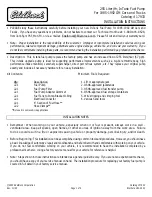
36 |
| 37
VEHICLE CONTROLS
VEHICLE CONTROLS
Adjusting the Seats
Make seat adjustments before driving to ensure the best comfort and safety.
Adjusting the Front Seats
Adjust the driver’s seat as far back as possible while
allowing you to maintain full control of the vehicle.
You should be able to sit upright and well back in the
seat, adequately press the pedals without leaning
forward, and grip the steering wheel comfortably.
The passenger’s seat should be adjusted so that it
is as far back from the front airbag in the dashboard
as possible.
The National Highway Traffi c Safety Administration and Transport Canada
recommend that drivers allow at least 10 inches (25 cm) between the center of the
steering wheel and the chest.
Power Driver’s Seat*
Move back and allow
suffi cient space.
Horizontal
position
adjustment
Height
adjustment
Seat-back
angle
adjustment
Reclining the seat-back too far can result in serious injury or death in a crash.
Adjust the seat-back to an upright position, and sit well back in the seat.
WARNING
Sitting too close to a front airbag can result in serious injury or death if the
front airbags infl ate.
Always sit as far back from the front airbags as possible while maintaining
control of the vehicle.
WARNING
*if equipped
Manual Seats*
Floor Mats*
Position the front seat fl oor mats properly, and anchor
them. If they are not properly positioned, the fl oor
mats can interfere with the front seat functions.
Do not put additional fl oor mats on top of the
anchored mats.
Height adjustment
(driver’s seat only)
Horizontal position adjustment
Pull up on the bar to move the seat,
then release the bar.
Seat-back angle
adjustment
Pull up the lever to
change the angle.
Sitting improperly or out of position can result in serious injury or death in a
crash.
Always sit upright, well back in the seat, with your feet on the fl oor.
WARNING
Unlock
Lock
*if equipped
















































